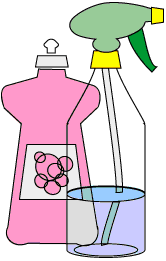 picture borrowed from You can -soap
picture borrowed from You can -soapBenchmark: Technology is essential to science for outer space and other remote locations, sample collection and treatment, measurement, data collection and storage, computatation and communication of information.
 picture borrowed from You can -soap
picture borrowed from You can -soap
Standard:
Demonstration: (teacher lead; hammer and feather) or Discrepant Event If the hammer and the feather were dropped at the same time from the same height, which would hit the floor first? What variable is being controlled? If the demonstration was performed in a vacuum, there would be surprising results. What do you think the results would be?
Special Needs Accommodations: cooperative teams buddy system stickers/rewards monitor teams student repeat directions Focus Question: WHAT DETERMINES HOW LONG IT TAKES FOR PAPER TO FALL THROUGH THE AIR ? Hypothesis Procedure Results (observations) Conclusions Use camcorder to film students results.
Multicultural Extension Inform students that Dr. W. Harris, an African Americn aeronautical engineer, helps NASA develop technology for aircraft of the future. For example, one airplane he helped design can carry 300 passengers on flights across the ocean at more than twice the speed of sound.
Make a Better P.T.
What makes a better p.t.? Is it one that falls faster, slower or one that spins more before hitting the floor?
Use camecorder to tape results to compare and analyze with graphic data. Integrate The Sciences
Theme Connection: The spinning fruits of a maple tree: What structural similarities do you see between the maple fruit and the p.t.?
Assessment: performance, sciencelog, portfolio
Home assignments:
Web Sites:
Funology--The Science of Having Fun
Adapted from Science Plus( Level Green copywright 1997) Holt, Rinehart and Winston publishers
Web Page Author: Carolyn Fitchett